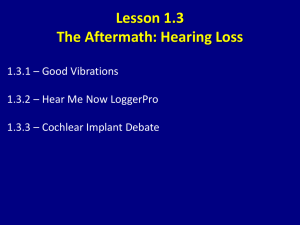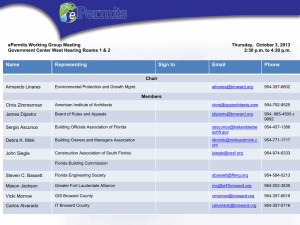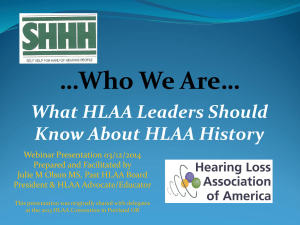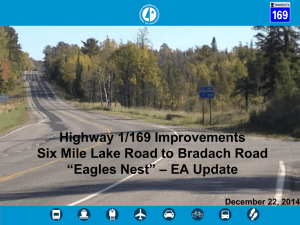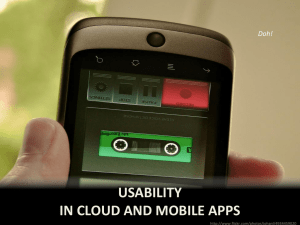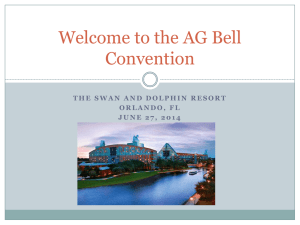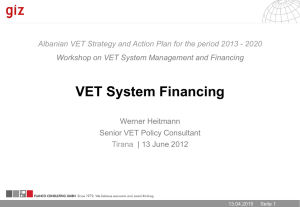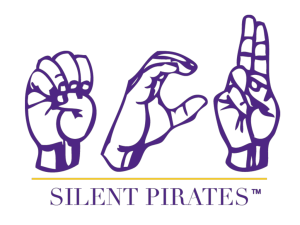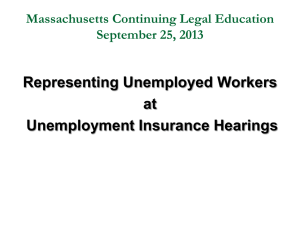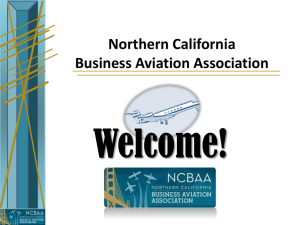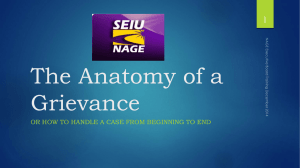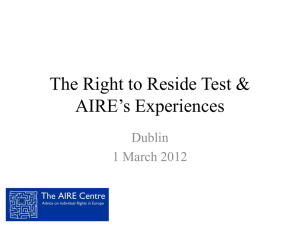Board hearing process presentation - Court of Appeals for Veterans
advertisement
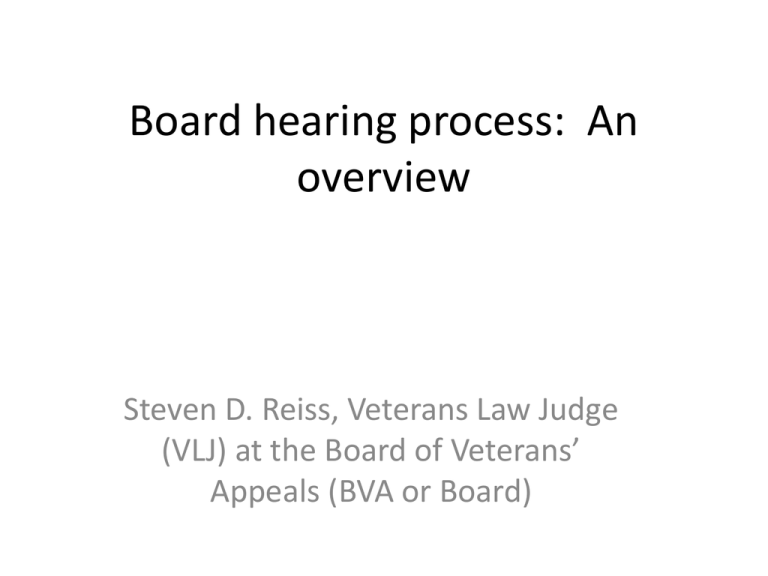
Board hearing process: An overview Steven D. Reiss, Veterans Law Judge (VLJ) at the Board of Veterans’ Appeals (BVA or Board) Right to a Board hearing • An appellant has a right to a Board hearing. • 38 C.F.R. § § 20.700(a), 20.703. Pre-hearing conference and formal hearing • The pre-hearing conference (which is off the record) and the components of that process and its imperatives; and • The actual on-the-record hearing Pre-hearing conference • Is contemplated to afford the appellant and his representative the opportunity to clarify the issues on appeal and to discuss the hearing procedures. • 38 C.F.R. § 20.708. Pre-hearing conference • Purpose of the pre-hearing conference • Elements and sequence of the pre-hearing conference. • Discussion of case law impacting hearings Purposes of the pre-hearing conference • To clarify the issues • To explain the process to the appellant so he is comfortable with the structure and sequence of events • To advise the appellant that VLJ may ask questions so that he is prepared to respond. • To identify any witnesses who may be testifying Pre-hearing conference: Purpose • To advise the appellant that: • Hearings conducted by the Board are non-adversarial. • Oath or affirmation required • Formal rules of evidence do not apply. • Cross-examination is not permitted. • 38 C.F.R. § § 20.700(c), 20.706 The pre-hearing conference: Elements and sequence • Identify the appellant (and his/her witnesses) • Go over the basic ground rules for the proceeding, i.e., the likely sequence of events at the hearing. Pre-hearing conference: Sequence of events • • • • • • • VLJ opening Oath/affirmation Representative’s opening statement Representative’s questioning VLJ questioning-3.103(c)(2) Representative’s closing statement Adjournment of hearing The pre-hearing conference: Elements and sequence • The VLJ acknowledges the importance of the hearing to the appellant, who has the right to speak at any point during the proceeding. • Advise appellant that with his consent, any witnesses can speak on his behalf Pre-hearing conference: Elements and sequence • The VLJ will note that once the hearing actually begins (when we go on the record), the VLJ will identify everyone in the room (or note the different locations as most Board hearings are now conducted by videoconference). Pre-hearing conference: Case law impacting hearings • Bryant v. Shinseki, 23 Vet. App. 488 (2010) • Procopio v. Shinseki 26 Vet. App. 76 (2012) • 38 C.F.R. § 3.103(c)(2) imposes two distinct duties on the VLJ: (1) a duty to fully explain the issues, and (2) a duty to suggest that a claimant submit evidence on an issue material to substantiating the claim. Pre-hearing conference: Case law impacting hearings • The VLJ will clarify the issues. This is critical because sometimes, based on the pre-hearing conference, issues may be recharacterized • VLJ may have to inform the appellant that the Board does not have jurisdiction over a particular claim. Pre-hearing conference: Case law as to the “issues” before the Board • Significant decisions impacting the identification of the issues: Rice v. Shinseki, 22 Vet. App. 337 (2009)-TDIU? Clemons v. Shinseki, 23 Vet. App. 1 (2009)-service connection generally? Evans v. Shinseki, 25 Vet. App. 7 (2011)-impact of selecting box 9A, which indicates that he wants to appeal all of the issues listed in the SOC and SSOC. DeLisio v. Shinseki, 25 Vet. App. 45 (2011)-the withdrawal of a claim must be explicit, unambiguous, and done with a full understanding of the consequences of such action on the part of the claimant. Pre-hearing conference: Prior hearings • This relates to whether the appellant testified at a prior hearing on some or all of the same issues that are currently before the Board. • Former VLJ versus a current VLJ. • In Arneson v. Shinseki, 24 Vet. App. 379, 386 (2011) the CAVC held that a claimant has the right to have the opportunity to testify at a Board hearing before all the VLJs who will decide his appeal. Pre-hearing conference: “Housekeeping issues” • Will new evidence be submitted? • Will there be a request to hold the record open? • Should the appeal be advanced on the Board’s docket due to age, financial hardship or serious illness? Pre-hearing conference: Recap • The purpose of the pre-hearing conference is to clarify the issues and to ensure the hearing goes smoothly so as to better serve the appellant. • It must be emphasized that anything substantive that is discussed at the prehearing conference is again addressed explicitly on the record. Hearing • The VLJ opening, identifying the appellant and any other witnesses by name, the location of the hearing, the location of the parties, the name of the attorney/representative and veterans service organization. • Following the Representative’s opening statement and initial questioning, the VLJ may ask a few questions. • As noted above, the VLJ advises the appellant that it is not an adversarial proceeding and that the VLJ is simply discharging his legal obligations, i.e., the VLJ is not crossexamining the appellant. 38 C.F.R. § 3.103(c)(2) • The duty to fully explain the issues • Duty to suggest the submission of evidence that may have been overlooked 38 C.F.R. § 3.103(c)(2): The issue • The discussion of the issues relates to the first duty, i.e., Rice, Clemons, Evans, DeLisio 38 C.F.R. § 3.103(c)(2): Submission of evidence • As to the second duty, the VLJ has to be familiar with the case because the VLJ must know why the claim was denied. 38 C.F.R. § 3.103(c)(2): Submission of evidence • In Procopio, the VLJ, who agreed to hold the record open for an additional medical nexus opinion, erred in failing to explain that a nexus opinion alone would be insufficient to substantiate the Veteran’s claims without evidence of in-service exposure to herbicides 38 C.F.R. § 3.103(c)(2): Submission of evidence • VLJ’s obligation extends to evidence not yet in existence • As the Court noted in Bryant, in Sizemore v. Principi, 18 Vet. App. 264 (2004), a Veteran seeking service connection for post-traumatic stress disorder described at a hearing his experiences in Vietnam. Id. at 274. • VLJ should have advised the Veteran as to the types of information that may help corroborate his claimed inservice stressors; VLJ failed to notify him that he could submit corroboration in the form of “buddy statements.” 38 C.F.R. § 3.103(c)(2): Submission of evidence • The VLJ may also inquire, in either a service connection or in claim seeking a higher rating, whether there is any potential evidence that may not yet be in existence that may help substantiate the claim. • Medical nexus statement • Lay evidence of onset of disability in service • Medical or lay evidence of current severity 38 C.F.R. § 3.103(c)(2) • Also additional theories, including those not raised by the appellant in light of the Federal Circuit’s decision in Schroeder v. West, 212 F. 3d 1265 (Fed. Cir. 2000) and its progeny, VA has an obligation to investigate all theories raised by the record or raised by a sympathetic reading of the claimant’s filing. End of Hearing • Following representative’s closing statement, the VLJ will ask the appellant whether he is satisfied with the hearing • VLJ will express appreciation for his appearance. • The VLJ will then formally adjourn the hearing
